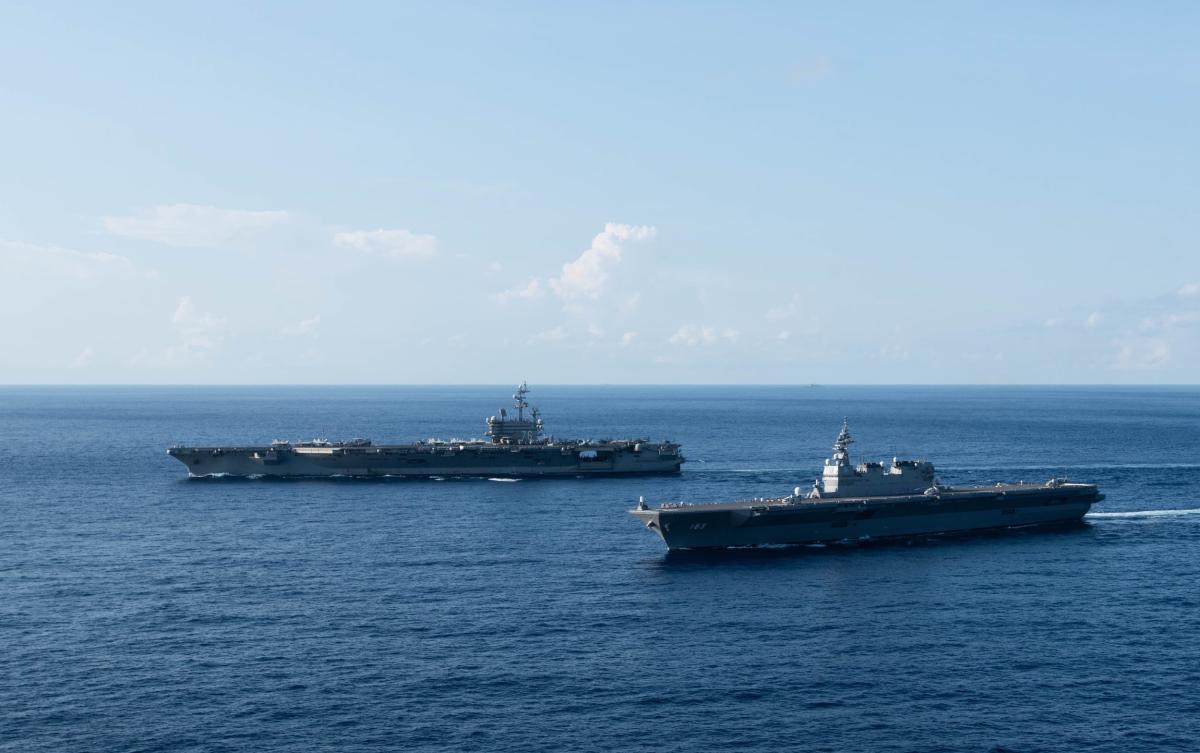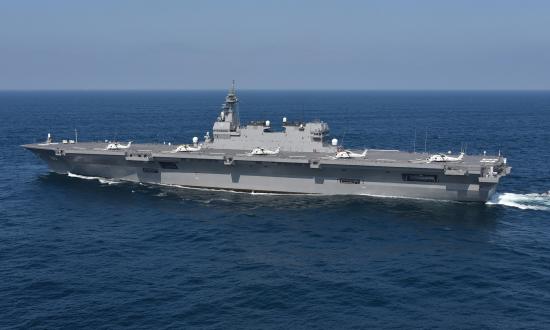Lightning aircraft carriers—aviation-capable vessels whose mainstay is the fifth-generation F-35B Lightning II short-takeoff and vertical-landing stealth fighter—are increasingly sailing the waters of the Asia-Pacific and will continue doing so. Indeed, Japan and South Korea jumped on the Lightning carrier bandwagon last year, with the former’s Izumo “helicopter destroyer” operating F-35Bs (albeit U.S. ones) for the first time and the latter announcing the CVX program that will see Seoul having a light flat-top in service early next decade. Similarly, the British dispatched the Lightning carrier HMS Queen Elizabeth to the Far East during its first operational tour. “Big Lizzie” and her sister ship, the Prince of Wales, could make more visits to the region in coming years.
These developments have invariably raised questions about the utility of the Lightning carrier in the Asia-Pacific operational environment. At War On The Rocks, John Bradford and Olli Pekka Suorsa addressed this issue in a piece titled “‘Lightning Carriers’ could be Lightweights in an Asian War.” The two authors are on point in arguing that these ships, “(r)elative to their huge costs . . . will do little to change the anticipated outcomes of the region’s most likely maritime combat scenarios.” Bradford and Suorsa explain—and rightly so—that the flat-tops “will offer a marginal additional capability that comes at high cost in comparison to what could be created through investments in long-range land-based aircraft and the development of more flexible, resilient, and distributed land-basing options.” However, Bradford and Suorsa do not mention the main reason for the Lightning carrier’s limited intrinsic operational utility in wartime—arguably its relatively meagre tactical aircraft complement. In circumstances in which the vessel could fight alongside with a U.S. supercarrier, however, this shortfall would not be as acutely felt.
Small Air Wing
Depending on its size, the Lightning carrier has an aircraft complement anywhere from one to two dozen. Japan’s Izumo will carry about only a dozen F-35Bs, while the South Korean CVX’s potency is marginally better at 16. Britain’s Queen Elizabeth-class flat-top typically deploys with about 20 Lightnings. The raison d’être of a flat-top is its aircraft complement, and that dictates the operations the ship can execute. Classified as small-deck carriers, Lightning carriers face the dilemma of what proportion of their airpower should be devoted to defence versus attack. Allocate more fighters to strike missions, and the carrier force’s susceptibility to threats increases. Conversely, set aside more aircraft for force protection, and the flat-top’s ability to project power declines.
The Lightning carrier force commander must strike a judicious balance between attack and defense. Bearing in mind the vessel’s capital-ship status and multibillion dollar price tag, its protection from enemy threats would be critical. Hence, a significant proportion of the ship’s aircraft complement would invariably be dedicated to defense. But with an air wing of less than two dozen F-35Bs, force protection against an adversary with potent antiaccess capabilities such as China would be a trying task. Indeed, commenting on Japan’s aircraft-carrier program, one defense writer puts this dilemma bluntly: “Would Japan really risk the lives of a thousand sailors just to put 10 F-35s in the air?” This statement would be just as applicable to any other Navy operating Lightning carriers.
Deploying with a U.S. Supercarrier
This operational liability of the Lightning carrier would, however, not come to the fore should it operate in tandem with a U.S. Navy supercarrier. Like Bradford and Surosa, most experts will delineate the flashpoints in the Asia-Pacific as the Korean peninsula, the Senkaku islands, the Taiwan Strait, and the South China Sea. However, a contingency in any of these hotspots would invariably draw in the United States to a degree, and it is quite possible that a U.S. aircraft carrier strike group would get deployed to the conflict zone. Indeed, Bradford and Suorsa note that Japan’s carriers “should be considered as assets of both their nation and a tight alliance with the United States.” In the same vein, with regard to any British flat-top deployment in the Asia-Pacific, the two authors observe that “while acting in the British national interest, the carriers’ combat operations will most likely take place within coalition contexts.”
Interestingly, despite making these statements, the two writers do not consider that during a combat scenario these ships—whether they be Japanese, South Korea, or British—are likely to operate together with any deployed U.S. supercarrier in a combined task force. In such circumstances, the capabilities the latter provide would mitigate the operational shortcomings of the former. To illustrate, the Lightning carrier’s lack of an airborne early warning platform would not be as acutely felt, as it could rely on the U.S. E-2 Hawkeyes. The same can be said for the small carrier’s lack of other aircraft, such as aerial tankers. Similarly, the 40-plus Super Hornet and/or F-35C conventional takeoff-and-landing strike fighters on the U.S. carrier could make up for the Lightning flat-top’s small-deck carrier quandary. In fact, the latter’s F-35B air group would contribute to the fighting capabilities of the combined carrier force.
Role as a Light Carrier
Any Lightning carrier operating with its large U.S. counterpart would then assume a secondary role given its relatively limited capabilities, in a throwback to World War II. In 1943–45, Independence-class light carriers and their larger Essex-class cousins made up the fast carrier task force that was so decisive in shaping the outcome of the central Pacific campaign. The Independence carriers—with a complement of about 30 aircraft, including 20-odd fighters—were usually given the more prosaic tasks of combat air patrol and antisubmarine warfare, leaving to the “big boys” the more glamorous duties of attacking Japanese warships and land bases.
This disposition of assets could be replicated in a joint U.S.-allied carrier force during wartime. In fact, such an entity comprising Lightning carriers and their heavier counterparts would be highly beneficial given the synergy such an arrangement would bring. For instance, the Lightning flat-top, with its shorter-ranged F-35Bs, could assume a key role as fleet air defender, leaving the U.S. supercarrier with more aircraft to project force against the enemy.
All that said, it is perhaps time to recognize Lightning carriers for what they are and not compare them unfairly to their much larger and more capable Nimitz-class brethren in the U.S. Navy. The esteemed naval commentator Robert Rubel maintains that aviation-capable platforms such as the Lightning carrier “can provide instrumentality in everything from disaster relief to gunboat diplomacy.” This is arguably what the vessel is best suited for—not so much as a first-class warfighter, but as a Swiss army knife that could be wielded in almost the entire spectrum of operations below a conventional war.






